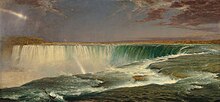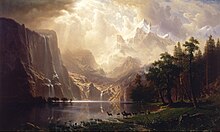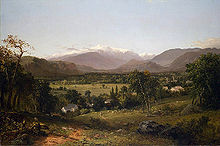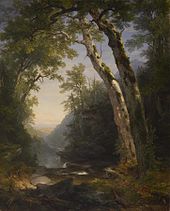Hudson River School

The Hudson River School was a mid-19th-century American art movement embodied by a group of
Works by second-generation artists expanded to include other locales in New England, the Maritimes, the American West, and South America.
Overview
The term Hudson River School is thought to have been coined by the New York Tribune art critic
Hudson River School paintings reflect three themes of America in the 19th century: discovery, exploration, and settlement.
Founder
Second generation




The second generation of Hudson River School artists emerged after Cole's premature death in 1848; its members included Cole's prize pupil Frederic Edwin Church, John Frederick Kensett, and Sanford Robinson Gifford. Works by artists of this second generation are often described as examples of Luminism. Kensett, Gifford, and Church were also among the founders of the Metropolitan Museum of Art in New York City.[10]
Most of the finest works of the second generation were painted between 1855 and 1875. Artists such as Frederic Edwin Church and
Female artists
Several women were associated with the Hudson River School. Susie M. Barstow was an avid mountain climber who painted the mountain scenery of the Catskills and the White Mountains. Eliza Pratt Greatorex was an Irish-born painter who was the second woman elected to the National Academy of Design. Julie Hart Beers led sketching expeditions in the Hudson Valley region before moving to a New York City art studio with her daughters. Harriet Cany Peale studied with Rembrandt Peale and Mary Blood Mellen was a student and collaborator with Fitz Henry Lane.[13][14]
Legacy
Hudson River School art has had minor periods of a resurgence in popularity. The school gained interest after World War I, likely due to nationalist attitudes. Interest declined until the 1960s, and the regrowth of the Hudson Valley[vague] has spurred further interest in the movement.[15] Historic house museums and other sites dedicated to the Hudson River School include Olana State Historic Site in Hudson, New York, the Thomas Cole National Historic Site in the town of Catskill, the Newington-Cropsey Foundation's historic house museum, art gallery, and research library in Hastings-on-Hudson, New York, and the John D. Barrow Art Gallery in the village of Skaneateles, New York.
Collections
Public collections
One of the largest collections of paintings by artists of the Hudson River School is at the Wadsworth Atheneum in Hartford, Connecticut. Some of the most notable works in the Atheneum's collection are 13 landscapes by Thomas Cole and 11 by Hartford native Frederic Edwin Church. They were personal friends of the museum's founder, Daniel Wadsworth.
Other collections
- Albany Institute of History & Art in Albany, New York
- Arnot Art Museum in Elmira, New York
- Berkshire Museum in Pittsfield, Massachusetts
- Brooklyn Museum in Brooklyn, New York
- Corcoran Gallery of Art, in Washington, DC
- Crystal Bridges Museum, in Bentonville, Arkansas
- Cummer Museum of Art & Gardens, in Jacksonville, Florida
- Detroit Institute of Arts in Detroit, Michigan
- Fenimore Art Museum in Cooperstown, New York
- Frances Lehman Loeb Art Center, in Poughkeepsie, New York
- Fruitlands Museum in Harvard, Massachusetts
- Gilcrease Museum in Tulsa, Oklahoma
- Haggin Museum in Stockton, California
- Hudson River Museum in Yonkers, New York
- Hunter Museum of American Art in Chattanooga, Tennessee
- Louvre Museumin Paris, France
- Mabee-Gerrer Museum of Art in Shawnee, Oklahoma[16]
- Marsh-Billings-Rockefeller National Historical Parkin Woodstock, Vermont
- Metropolitan Museum of Art, in Manhattan, New York
- Munson-Williams-Proctor Arts Institute, in Utica New York
- Museum of Fine Arts, Boston, in Boston, Massachusetts
- Museum of White Mountain Art in Jackson, New Hampshire
- National Gallery of Art in Washington, DC
- Newark Museumin Newark, New Jersey
- Newington-Cropsey Foundation in Hastings-on-Hudson, New York
- New-York Historical Society, in Manhattan, New York
- Olana State Historic Site, in Hudson, New York
- St. Johnsbury Athenaeum, in St. Johnsbury, Vermont
- Thyssen-Bornemisza Museum, in Madrid, Spain
- The Heckscher Museum of Art, in Huntington, New York
- Virginia Museum of Fine Arts, in Richmond, Virginia
- Worcester Art Museum, in Worcester, Massachusetts
- Wadsworth Atheneum, in Hartford, Connecticut
The Newington-Cropsey Foundation, in their Gallery of Art Building, maintains a research library of Hudson River School art and painters, open to the public by reservation.[17]
Notable artists
|
|
|
See also
- List of Hudson River School artists
- List of paintings by Frederic Edwin Church
- List of paintings by Thomas Cole
- List of works by Albert Bierstadt
- Macchiaioli
- National Romanticism
- White Mountain art
- Young America Movement
References
Notes
- ^ Howat, John K (1987). American Paradise: The World of the Hudson River School. New York: Metropolitan Museum of Art, Harry N. Abrams, Inc. pp. 3, 4.
- ^ Kornhauser, Elizabeth Mankin; Ellis, Amy; Miesmer, Maureen (2003). Hudson River School: Masterworks from the Wadsworth Atheneum Museum of Art. Wadsworth Atheneum Museum of Art. p. vii. Retrieved June 26, 2016.
- ISBN 978-0-943651-43-9. Retrieved June 23, 2016.
- ^ "The Hudson River School: Nationalism, Romanticism, and the Celebration of the American Landscape". Virginia Tech History Department. Retrieved June 26, 2016.
- ^ John K. Howat: American Paradise: The World of the Hudson River School, S. 311
- ^ ISBN 9780231138208.
- ^ Boyle, Alexander. "Thomas Cole (1801–1848) The Dawn of the Hudson River School". Hamilton Auction Galleries. Retrieved 19 December 2012.
- ^ "Asher B. Durand". Smithsonian American Art Museum: Renwick Gallery. Smithsonian Museum. Retrieved June 26, 2016.
- ^ Angela Miller, The Empire of the Eye (1996); Alfred L. Brophy, Property and Progress: Antebellum Landscape Art and Property, McGeorge Law Review 40 (2009): 601-59.
- ^ Avery, Kevin J. "Metropolitan Museum of Art: Frederick Edwin Church". Metropolitan Museum of Art. Retrieved 19 December 2012.
- Corcoran Museum of Art. Archived from the originalon 15 July 2011. Retrieved 19 December 2012.
- ^ Potter, Russell A. "Review of 'The Voyage of the Icebergs: Frederic Edwin Church's Arctic Masterpiece'". Rhode Island College. Retrieved 19 December 2012.
- ^ Dobrzynski, Judith H. "The Grand Women Artists of the Hudson River School". Smithsonian. Retrieved 28 May 2013.
- ^ "Remember the Ladies: Women Artists of the Hudson River School". Resource Library. Traditional Fine Arts Organization, Inc. Retrieved 28 May 2013.
- ^ Zimmer, William (October 17, 1999). "Hudson River School Just Keeps on Rolling". The New York Times. Retrieved May 15, 2018.
- ISBN 0-9640163-1-1.
- ^ Hershenson, Roberta (November 7, 1999). "Work Is in Dispute, but Cropsey's Home Is Open". The New York Times. Retrieved April 29, 2018.
- ^ Encyclopedia Britannica
- ^ Allaback, Sarah. "19th Century Painters: Hudson River School" (PDF). 2006. Hudson River Valley National Heritage Area. Archived from the original (PDF) on 16 May 2013. Retrieved 19 December 2012.
- ^ Rickey, Frederick. "Robert W. Weir (1803–1889)". United States Military Academy. Archived from the original on 29 September 2012. Retrieved 19 December 2012.
Sources
- American paradise: the world of the Hudson River school. New York: The Metropolitan Museum of Art. 1987. ISBN 978-0-87099-496-8.
- Avery, Kevin J., & Kelly, Frank (2003). Hudson River school visions: the landscapes of Sanford R. Gifford. New York: The Metropolitan Museum of Art. ISBN 978-0-300-10184-3.)
{{cite book}}: CS1 maint: multiple names: authors list (link - Ferber, Linda S. The Hudson River School: Nature and the American Vision. New York Historical Society, 2009.
- Sullivan, Mark W. The Hudson River School: An Annotated Bibliography. Metuchen, NJ; Scarecrow Press, 1991.
- Wilmerding, John. American Light: The Luminist Movement, 1850–1875: Paintings, Drawings, Photographs. National Gallery of Art, Washington, D.C., 1980. OCLC 5706999.
External links
- The Hudson River School, American Art Gallery
- The Hudson River School, The Metropolitan Museum of Art
- National Park Service overview of Hudson River School
- Wadsworth Atheneum's Hudson River School Collection
